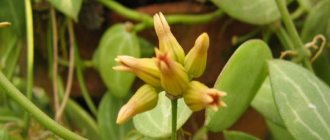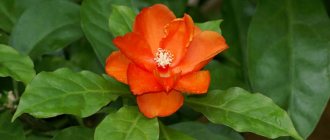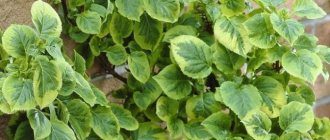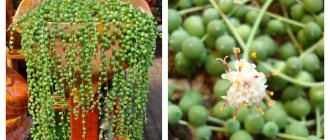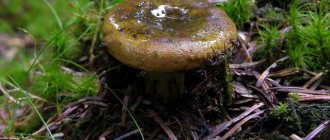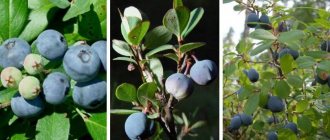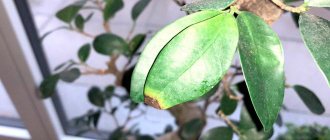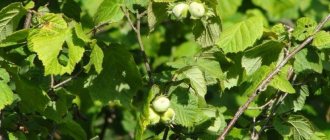Description
Roicissus is a plant from the grape family, native to Central Africa.
In its homeland, the flower grows in tropical forests. Its genus includes 10 species.
It has simple or compound (three-part) leaves, green in color, located on long, flexible stems.
Under natural conditions, shoots reach a length of up to 6 meters. At home, the maximum length of rhoicissus stems is 3 meters.
The birch tree blooms with small, false umbrellas. However, in indoor conditions it almost never blooms.
Home care
The plant does not require any special care and can grow in any conditions. But in order for the plant to look especially attractive, you should follow some rules for its maintenance and cultivation.
Lighting and temperature
Indoor birch grows best in bright light. But the flower does not like direct rays of the sun, so it is preferable to keep it on the south or west side. In bright light, the leaves will turn pale and the flower will begin to lose its attractiveness.
However, if this is not possible, it is not necessary to do this - the flower will spend the rest period just fine in normal room conditions at average temperature.
In summer, a home birch tree can be placed outside in a place that is not exposed to direct sunlight.
Roicissus easily tolerates growing away from windows. Its hanging shoots look very beautiful in floor flower stands, so you can decorate empty corners of your room this way.
Watering and air humidity
Frequent and abundant watering is a necessary condition for maintaining a birch tree.
In this case, soft water is used, since roisissus does not like lime. In winter, the plant needs to be watered much less often, but only when kept in a cool room.
If the room is hot, then the frequency of watering should be the same as in summer.
A native of tropical forests, rhoicissus loves high air humidity.
In summer it needs to be sprayed regularly. This procedure is also important for cleaning leaves from dust.
In a plastic pot there is a risk of soil becoming waterlogged, since the water does not evaporate from it. Excessive watering of the soil in such a pot risks rotting the root system.
During watering, fertilizers must be added to the water every two weeks. Any universal mixtures for indoor decorative foliage plants sold in retail outlets are suitable.
You can feed it with drinking tea and infusion of chamomile. They also contain some nutrients.
Soil and transplantation rules
After purchasing, the birch tree should be immediately freed from the transport substrate and transplanted into a new pot.
If the root system is completely entangled in the earthen ball, then select a pot 5-6 centimeters larger than the store-bought one.
Unlike other plants, rhoicissus does not require time to acclimatize; it tolerates changing conditions and any transplantation well.
Roicissus prefers loose nutrient substrates, the basis of which is turf and leafy soil. You can add humus to the mixture, one part to 2 parts turf and 2 the same amount of leaf soil. For looseness, one part of sand or peat-sand mixture is also added.
During the growth period, when transplanting rhoicissus, the pot is taken 3-4 centimeters larger than the previous one. Be sure to install drainage to prevent the plant from flooding.
Crown formation
The splendor of the bush gives the birch a special decorative appearance.
Selecting a location
For good health, roisissus needs long-lasting, but not bright, lighting. Direct sunlight is harmful to vine leaves and even with short exposure can lead to a change in their color. Taking this into account, when choosing a place to place a pot, it is advisable to give preference to the south or west side of the house.
During the dormant period, the birch tree can be placed inside the room, maintaining average temperature values within +15°C. In summer, the plant will feel great on the balcony or even outdoors, the main thing is to protect it from direct sunlight and protect it from drafts.
If there is not enough space for the vine near the windows, it can be left away from them. For example, shoots hanging from a pot will look great when placed in floor flower stands located in the corners of the room.
Air temperature and humidity
The optimal temperature for the growth of roisissus will be +16...+25°C during the warm period of the year, and about +12...+15°C during winter dormancy. In this case, the level of humidity in the room does not play a big role and can be maintained within the standard range of 50–60%.
Pests and diseases
This flower is extremely rarely affected by pests.
Scale insects, aphids, thrips, and spider mites may appear on it.
They are combated by washing the foliage with warm water with the addition of laundry soap and treating with insecticides.
Rhoicissus can be susceptible to diseases in winter. If the soil is kept cool and the soil is allowed to become waterlogged, the root system of the plant will be affected by fungus.
From lack of moisture, the leaves begin to turn yellow and dry out..
After watering is normalized, the rhizissus quickly recovers. Yellowing leaves may also indicate a lack of fertilizer.
shed its leaves sharply from constant exposure to drafts or a room with sudden temperature changes.
This often happens when keeping a plant on a balcony with the windows open. Therefore, in cool weather, you should close the balcony at night so that your birch tree does not freeze.
Brown spots appear on the leaves due to waterlogging . These same symptoms indicate a lack of nitrogen or phosphorus in the soil. Water the rhoicissus with any nitrogen fertilizer, and the flower will quickly heal. Remove all affected leaves and stems immediately.
Growing in too dense soil leads to oxygen starvation of the flower roots. This is signaled by curling and subsequent falling of the leaves .
Difficulties of growing indoor birch
In general, this plant variety adapts to any conditions and is not considered capricious. It is rarely affected by pests and diseases, but only if it is properly cared for. Rhoicissus diseases manifest themselves in the form of rot or deterioration in appearance due to improper care:
- brown spots may indicate sunburn and in this case the plant should be covered with a curtain from the midday sun;
- small leaves and elongated shoots indicate a lack of light;
- yellowing of leaves is a sign of moisture disturbance and soil depletion;
- if the leaves dry out and fall off, this may indicate both a lack of air humidity and a natural renewal process.
Among the pests on the vine and most often you can find spider mites, aphids, thrips and scale insects. In this case, the plant is isolated from other flowers in the room and treated with insecticides.
Benefits and harms
An unpretentious roisissus will be useful to people with a personality opposite to their character.
For those who are literally fixated on keeping the house clean and tidy, the plant will help them be more relaxed about cleaning and putting things in order.
A home flower helps soften people who are too principled. A flower that adapts to any conditions helps a person adapt to unfavorable living conditions.
He will teach you to be above all material wealth, to be calm about the fuss around making money.
As for health, indoor birch helps fight intestinal diseases. It also improves the body’s immunity and adaptability to adverse environmental influences.
Birch is a wonderful type of indoor plant for those housewives who want to green up their own apartment, but do not have enough time to care for the flower. With minimal care, the plant will delight you with its appearance and give the room a stylish look.
Roicissus
Rhoicissus is an evergreen ornamental foliage plant. This vine has a very impressive appearance. It is directly related to the grape family (Vitaceae) and the genus Rhoicissus. It unites more than 10 species of different plants. In nature, the plant is found in tropical regions of South Africa.
Roisissus is quite popular in indoor floriculture. He is unpretentious and undemanding in care. It can grow in both shaded and sunny areas, and also thrives in both cold and warm conditions. Has simple leaves. Small flowers are collected in umbrellas. But at the same time, rhoicissus practically does not bloom at home. It is a fast-growing plant that can grow up to 150 centimeters in height.
When and how does it bloom
Cissus may bloom, but it is inconspicuous and unattractive. The inflorescences are collected in an umbrella; small white or yellow flowers do not stand out particularly against the background of the leaves.
- Types of flowers. Simple inflorescences, collected in racemes. When pollinated, they turn into black or red berries.
- Flower shape. Flat, flowers are white or yellow. Their size does not exceed 5-8 mm.
- Flowering period. At home, it blooms extremely rarely; most often this occurs during the growth period, i.e. from May to the end of September.
Cissus is not attractive as a flowering plant
Caring for rhoicissus at home
Illumination
It feels best in bright, but diffused light. Make sure that the foliage is not exposed to direct sunlight, as this may cause its color to become pale.
Temperature
Feels great at temperatures of 16–25 degrees in the warm season. With the onset of winter, it is recommended to move some types of roisissus to a cool place (from 10 to 12 degrees).
How to water
In the warm season, watering should be plentiful. In the autumn-winter period, you need to be especially careful about watering. It is reduced enough so that the soil dries out a little between waterings. You must not allow the earthen clod to dry out or become waterlogged, which can lead to the plant shedding its leaves and causing its shoots to become crushed and dry out. Also, due to stagnation of water in the soil, brown spots appear on the leaves, and mold forms. This can also cause the leaves to curl.
Air humidity
Liana is particularly undemanding to the level of air humidity. However, it must be borne in mind that dry air causes the tips of the leaves to begin to dry out. Therefore, it needs to be sprayed from time to time.
Fertilizer
During intensive growth, which is observed in spring and summer, the plant needs feeding. At the same time, you need to feed it once every 2 or 3 weeks and use complex fertilizer for this. If the plant does not have enough nutrients, it will begin to grow very slowly.
Features of transplantation
Rhoicissus transplantation is carried out in the spring, once every 2 or 3 years. However, fresh soil must be added annually. The same vines that grow in the tub are replanted as the tub itself rots.
Reproduction methods
This very spectacular vine can be propagated in several ways. So, to do this, you can cut cuttings or divide an overgrown bush of an adult plant. It can also be grown from seeds.
As a rule, the bush is divided in spring. This procedure is recommended to be carried out simultaneously with the transplant. By the way, you need to use a very sharp knife to divide.
Propagation by cuttings can be carried out year-round, but experienced gardeners advise doing this in January or February or in the spring. For rooting, cut cuttings are planted in a small pot filled with soil. In this case, several cuttings can be planted in one container at once, namely 3 or 4 pieces. It must be placed in a warm place. So, the temperature should always be between 20–22 degrees. After 2.5–3 weeks, roots should appear on the cuttings. Rooted cuttings need to be planted in different containers, which need to be filled with a special soil mixture. You can do it yourself; for this you just need to combine turf, leaf and humus soil. Don't forget about a good drainage layer. After the cutting is planted in a separate flower pot, it needs to be provided with abundant, regular watering.
Pests and diseases
This plant is most often inhabited by spider mites and scale insects.
Some tips
- In order to form a beautiful bush, you need to pinch the shoots.
- In winter, moldy fungus very often appears on the roisissus, and it also rots easily during this period.
- In winter, it is necessary to move the vine to a place where it will be cool, and also to significantly reduce watering. During this period, she experiences a period of rest.
Roicissus diseases
The plant rarely gets sick. There are a number of key explanations for this:
When the leaves turn yellow on both sides, this means that the plant has been infected by spider mites. It's easy to notice. This is a thin web. To get rid of the disease as quickly as possible, it is necessary to remove the affected leaves and treat the plant with a liquid prepared with garlic or onions. In addition, you can use chemicals - insecticides;
Popular: Decorating your home by planting an areca-chrysalidocarpus palm
When the roots rot, it means that the plant is affected by a fungal infection. Moreover, not the roots themselves are affected, but also the bases of the cuttings. Where does this fungus come from? A fungal infection infects a plant from the ground. That is, if you are replanting a plant or bought it in a store, then the first thing you need to do is disinfect the soil. Fungus can also appear due to improper care. This means that the plant has been watered many times. The plant literally floats in water. You can't do this! The plant will die immediately. To restore a birch tree, you need to transplant it into a new container with soil (disinfected) and stop flooding the plant. When many small insects are noticed on the surface of the shoots, on the back side of the foliage, it means that aphids have appeared. It is necessary to immediately eliminate insects using chemicals or soap solution;
When a light coating begins to appear on the tender leaves of a birch tree, then all the symptoms indicate powdery mildew. The leaves fall off and the plant dries out. To cure a birch tree, you need to buy drugs, for example, Skor or Topaz;
A disease like scale insects appears as a result of improper care. It is expressed by the appearance of small growths on the surface of the plant. But Roicissus can be cured. To restore it, it is worth using funds and providing watering. You also need to loosen the soil.
Even a beginner in gardening can grow the plant, as it is unpretentious. There is one condition for indoor grapes: it does not prefer direct sunlight. It is more correct to grow in hanging pots, because the plant is considered a creeping plant - it will spread along the support of the pot. And most importantly, it does not bring additional troubles to the owner when one does not forget about the need to use exclusively warm, settled water for irrigation.
Currently reading:
- Exquisite juncus (rumen) spiral-shaped in the interior
- Planting to decorate the site with three types of coniferous trees
- Description of 12 types of late cabbage varieties for planting
- Caring for an evergreen succulent: wax ivy
Share the news on social networks
About the author: Vladimir Petrovich Efremov
Chief agronomist of the limited liability company “Association of Peasant (Farm) Farms “Kuznetsovskaya””, Ilovlinsky district of the Volgograd region.
Cissus: care at home
Cissus is otherwise called indoor grape, birch, grape ivy or indoor vine. The plant is very popular due to its dense, bright green foliage with a glossy sheen around elastic climbing stems, amazing growth rate and versatility - cissus feels good in a variety of conditions: be it an apartment, office, store or medical facility. In addition, the culture is completely unpretentious, so both an experienced gardener and a beginner in this matter can decorate their home with indoor vines.
Features of cissus
Cissus is a genus of plants belonging to the Vine family. The name of the culture is translated from Greek as “ivy.” From here it becomes clear that the flower belongs to the category of hanging flowers. At home (that is, in hanging pots, baskets, flowerpots, etc.) only a few types of crops are grown, for example, cissus antarcticus (indoor grapes), cissus variegated, etc. The genus includes about 300 species that are found in wildlife, mainly in areas with a hot tropical climate. Some of them, including those mentioned above, are used for practical purposes, for example, as food, medicine for malaria, building material for hedges, etc.
The liana is characterized by very rapid growth, but only when the most favorable conditions are created for it. Creeping shrub is often grown in winter gardens.
Cissus flowers
Plant species
The genus Cissus consists of more than 300 species, each of which is divided into several varieties. Among such a large number of varieties, only a few plants are adapted to living indoors:
- Cissus rhombifolia . It is a vine with long curly elastic stems densely covered with brown hairs. From the name it is clear that the leaves of the plant are diamond-shaped and colored bright green. The plant spreads its stems in all directions, weaving around the surrounding surface, clinging to support with the help of tendrils covering the stems.
This species is fast-growing: by providing the most favorable environment, you can achieve incredible growth rates - up to 200 cm in one growing season. The culture is characterized by amazing endurance, thanks to which it actively develops even in less than favorable conditions. Cissus rhombifolia has become widespread in home floriculture. When kept indoors, the culture also demonstrates rapid growth.
Common types of cissus flowers and their photos
Of the huge number of varieties of indoor grapes, only a few of them are grown at home.
Cissus Antarctica (kangaroo creeper)
Antarctica is the most common shade-tolerant species, which is a herbaceous climbing vine that grows up to two and a half meters. The dark green, smooth foliage with jagged edges is ovoid, up to twelve centimeters long and up to eight centimeters wide. On the petioles and stems of the Antarctic cissus, as can be seen in the photo, there is brown pubescence. The inflorescences consist of small greenish flowers.
Cissus rhombifolia (grape ivy)
Diamond-shaped cissus is characterized by thin, highly branched stems reaching one and a half meters in length. The leaves consist of three parts, have a diamond shape and a dark green color on the upper surface, and their lower part is reddish. Red-brown hairs are clearly visible on the stems, tendrils and petioles. Green flowers are collected in clusters. The fruit is a red edible berry.
Rhomboid cissus is usually grown on a support (see photo). Can be located in a shaded area. Of the varietal varieties, Cissus Helen Danica, also shown in the photo, is very popular among gardeners.
Cissus variegated (bicolor, discolor)
A very beautiful species, but requiring more attention to care than the others. It is very important for him to maintain the correct temperature and sufficient air humidity. Cissus versicolor is a vine with reddish-purple stems that, in good conditions, grow up to two meters in length.
It has delicate, thin tendrils and velvety, glossy leaves that are reddish-green with purple veins, spots, and a pattern of silver on the upper side, with the underside being dark pink. They have an elongated heart-shaped shape, up to ten centimeters long and five to eight centimeters wide.
The umbrella inflorescences consist of small yellow flowers. A peculiarity of this species is that it can shed its leaves in the winter. If this happens, you need to trim the stems and reduce watering. With the onset of spring, foliage will appear again.
Cissus quadrangularis
A rather unusual species for cissus, the vine of which is distinguished by thick shoots with four edges and small leathery leaves of a trilobed shape. The plant can grow up to one and a half meters. Flowers collected in inflorescences may have a white, yellow or green tint.
cactus
A rare species, it is a vine whose fleshy and succulent stems resemble varieties of cacti. There are no leaves, and tendrils emerge from the internodes. Grows very well using hydroponics.
Cissus Jutta
This cissus is a perennial erect succulent. It has thick pointed oval leaves of olive color with a reddish tint and a waxy coating. The plant can reach two meters in height. The stem is skittle-shaped and branches at the top into fleshy branches. With age, the yellow-green bark begins to peel off into ribbons resembling paper.
Cissus Baynesa
This species is also a perennial shrub that resembles succulents. Its stem can resemble a ball or a bottle, the lower part of which can be up to forty centimeters high and about twenty centimeters wide. The top of the plant branches out in the shape of a fork.
The jagged, pubescent, tomentose foliage on short petioles is trifoliate and bright green in color. The color of the bark varies from light yellow to green. The flowers have a yellowish-green tint.
Cissus Tuberose (caudex)
The appearance of this deciduous vine is quite exotic, due to the fact that it has a caudex - a bizarre thickening at the bottom of the trunk. In young plants it is green in color, and later a thin silvery bark forms on it. It peels off and is renewed every year.
The internodes of long stems (up to two centimeters in diameter) contain aerial roots. When the vine reaches the ground, they grow into it and form new shoots. The flexible, carved foliage has a five-lobed shape and resembles a Canadian maple. Its diameter can reach seven centimeters.
A distinctive feature of Cissus tuberose is the presence of mustaches, which act as a kind of suction cups. With their help, the plant can easily climb up a support and any smooth surface, such as a wall.
Striped cissus (striata)
Cissus striata is a robust, thin, climbing perennial that can reach ten meters in length. It has reddish shoots and three- or five-fingered leaves about five centimeters in diameter. They are ovoid in shape and have a leathery, glossy, bright green surface.
Greenish flowers are collected in corymbose inflorescences. The fruits are black berries no more than one centimeter in diameter.
Cultivation care
As mentioned earlier, cissus does not require special care. However, for faster and more active growth, the plant needs certain conditions. In addition, proper care and well-chosen conditions will provide the plant with protection from pests and the prevention of various diseases. Growing cissus must meet a number of requirements and include several important activities:
- Temperature regime . The vine is native to hot southern countries, so the plant is very heat-loving. For normal growth, it needs high temperatures: in spring and summer - from 18 to 25 degrees, in autumn and winter - 17-19 degrees. Indicators below 10 degrees are strictly unacceptable; it is also necessary to protect the vine from sudden temperature changes and drafts. Failure to comply with these conditions will result in the plant losing its foliage.
- Humidity . High air humidity is an important condition for normal growth and development of cissus. In winter, the bush must be sprayed (this can be done with a spray bottle) twice a day, and in summer - once a day. A small bush can be gently rinsed with a warm shower. It is recommended to regularly wipe the foliage of large specimens with a damp cloth.
- Illumination . Active growth of the vine occurs in bright, diffused sunlight. The specific requirements for this condition vary depending on the plant species. For example, rhombifolia cissus feels comfortable in bright light, and Antarctic cissus is tolerant of shaded rooms (this could be a bathroom, hall, etc.).
- Watering . Dense foliage, many shoots, rapid growth require regular, abundant watering. At the same time, moisture should not be allowed to stagnate in the root system of the flower. The soil in the pot should be moderately moist. You can tell that a plant needs watering by looking at the condition of the top layer of soil - it dries out, but does not crack (cracks indicate a serious lack of moisture, which is best never to reach). Starting from mid-October, the frequency of watering must be reduced.
- Fertilizer . It is recommended to do complex mineral fertilizing once a week during the entire growing season at any time of the year, except winter (at this time the crop does not need intensive nutrition). If a dormant period was not organized during the cold season, fertilizer continues to be applied once every two weeks. In this case, the mixture for feeding should be the least concentrated.
- Trimming . The event is held in the spring. The procedure involves shortening old shoots that have lost their decorative value. It is recommended to pinch young stems - this promotes their more active growth and branching.
- Transplant . The crop is transplanted into new pots using the transshipment method (that is, preserving the earthen clod). In the same way, young plants are replanted every year. When the crop reaches the age of five years, transplants are reduced to once every 2-3 years. Before each event, a drainage layer consisting of sand, peat, humus and soil, taken in equal quantities, is placed on the bottom of the pot.
Transplantation by transshipment method
Secrets of success
Roycissus is not picky about air humidity. However, even occasional spraying with warm, soft water will benefit the plant. Periodically it is necessary to wipe the leaves with a damp cloth. Roycissus loves to “shower.” Don’t be lazy and give him water treatments once a month. This allows you to free small hairs covering the stems, tendrils and undersides of leaves from dust.
In indoor conditions, Roycissus flowering is a rare occurrence, but in the spring, when the plant begins to develop intensively, feeding is required. Until the end of summer, complex fertilizer is applied 2 times a month, which can be easily purchased in a specialized store. It is first diluted with warm water.
Periodically, dry leaves must be removed and the tops of the shoots pinched so that lateral shoots form more intensively.
Spring is the best time to transplant. The soil and pot are replaced every 2–3 years. The container is taken much larger than the previous one, because Roycissus grows quickly. A good drainage layer is placed at the bottom so that moisture does not linger and cause rotting of the root system. The plant is not picky about the composition of the soil mixture. You can safely buy a universal substrate.
Reproduction of cissus
Due to its rapid growth, propagation of the crop is not a problem. There are several ways to increase the liana population:
- Growing from seeds . This is how arctic cissus is most often propagated. Planting is carried out in the spring. To do this, prepare a small container in advance and fill it with peat and sand. Then the substrate is moistened and seeds are laid out on its surface. Next, lay a thin layer of soil on top and cover the container with film or glass. The room where the box with seeds is located is regularly ventilated. Seedlings on which two fully formed leaf plates have appeared are transplanted into separate pots. Further transplants are carried out as the “young animals” grow.
Cissus sprouts from seeds
First steps after purchase
The purchase of Roycissus should be approached responsibly. Before you give money for a plant, you need to carefully examine the stems and leaves, which should be free of brown spots, dark spots, cuts and scratches. You need to carefully check the internodes for the presence of small insects that like to hide there. Dry leaf tips should be a concern, as should limp stems or mold on the sides of the pot and on the soil. You can buy a support in advance for a plant that will need it very soon. If you plan to use Roycissus as an hanging plant, it would be a good idea to buy a hanging pot. When the bush is already at home, at first it must be isolated from other representatives of the flora. But before sending Roycissus for a short quarantine, the leaves and stems are treated with a special solution against pests. After a couple of weeks, you can put the plant where its permanent place will be.
Diseases and pests
Cissus is resistant to diseases and the effects of various pests and parasites. However, it is not always possible to avoid such problems. Among the insects that pose a threat to the plant are:
- mealybug (an insect with a rounded white body, covered with a shell with a whitish coating);
- scale insect (the body of the insect is covered with a brownish shell).
You can get rid of a small number of pests manually - remove insects from the vine and wash the plant. You can also use various infusions - from garlic, tobacco, orange. A large population of pests can only be controlled with the help of modern insecticides.
Cissus diseases are almost always associated with improper crop care:
- If black spots appear on the surface of the foliage and the leaves begin to fall off, then the cause is most likely an excess of moisture in the soil. The solution to the problem is to significantly reduce watering (so that the top layer of soil dries out by 2-3 cm). If this does not help, you should check the roots. If there is rot, it is necessary to remove the affected parts and move the vine to another pot with a new substrate.
Black spots on leaves
Dried yellowed foliage
Roicissus transplant
During the first years, the plant is replanted every spring, gradually increasing the size of the flower pot. Starting from three years, it will be enough to replant the roisissus every two or three years, but do not forget about fertilizers and update the top layer of soil in a flower pot or tub every spring. The soil mixture is prepared from equal parts of leaf soil, turf soil and humus.
Growing plants at home - Roicissus
Rhoicissus is an indoor vine.
Because of the original shape of its leaves, it is called “domestic birch.” The flower is unpretentious, and at the same time it is highly decorative. It feels good in cold and warm weather, and is also unpretentious to lighting.
It is very popular among indoor plant lovers.
The plant is fast growing and can grow up to 150 centimeters in length.
The most popular types are rhombic and cape.
Rhomboid (Rhoicissus rhomboidea), birch
A liana with stems up to 1.5 m long and evergreen leaves. The leaf blades consist of three diamond-shaped lobes. The upper side is a rich emerald color, the lower side is light and matte. The stems have thin tendrils. Recommended for decorating walls and columns as an upright vine and as a hanging plant in flowerpots.
Cape (Rhoicissus capensis)
Decorative climbing vine with a high growth rate. Used for growing on supports and as a hanging crop. The plant has beautiful leaves that resemble grapes. The size of the leaf plate reaches 20 cm in diameter, the length of the stems is up to 2 m.
Home care
Illumination
Loves good lighting, but the light should be soft and diffused , since direct sunlight causes burns and discoloration of the leaves. Feels good on windowsills. If the windows face south, it is recommended to shade the pot at midday.
Temperature
In spring and summer it prefers moderate temperatures ranging from 20–23°C. With the onset of cold weather, it is recommended to keep the plant at a lower temperature, 10–12°C. Liana doesn't like the cold. If the thermometer in the room shows 5°C for a long time, the roiscissus may die.
How to water?
The plant does not like either waterlogged or too dry soil. Moisturizing is required when the soil dries 1–2 cm from above. Any water that drains from the pot into the tray must be poured out. After watering, it is recommended to carefully loosen the soil without disturbing the roots.
Important! You need to water with settled or filtered water at room temperature (20–23°C).
In spring and summer, abundant watering is required. In autumn and winter, the plant requires significantly less moisture, but it all depends on the temperature. If the room is warm (20–23°C), watering is carried out according to the “summer” schedule. If the plant overwinters at 10°C, frequent moistening is not required. It is necessary to ensure that the soil does not dry out.
Air humidity
Roisissus has no special requirements for air humidity. But you need to remember that in dry air the tips of the leaves will dry out. Spraying with water at room temperature will help get rid of the problem.
Fertilizer
The plant needs feeding in spring and summer, during the period of intensive growth. It is necessary to apply complex fertilizer for decorative deciduous plants once every 2–3 weeks. In autumn and winter, fertilizing should be abandoned.
Features of transplantation
Rhoicissus is replanted using the transshipment method, in the spring, once every 2–3 years. In the intervals, new soil is added. Plants growing in a tub are replanted when the container rots.
The pot should be chosen “with a reserve”, 3-4 cm larger than the previous one, so that the root system has enough space to grow. A drainage layer is placed at the bottom and a support for the plant is installed.
For replanting, take loose universal soil with neutral acidity. You can buy it in a store or make it yourself in the following proportions:
- humus, leaf soil, turf soil, coarse sand (in the ratio 1:1:1:0.5);
- loamy soil and compost (1:1 ratio);
- garden, turf and leaf soil, river sand (in the ratio 1:1:1:0.5).
The pot with the flower is placed in the shade for 2–3 days, then transferred to a permanent place. You can feed the plant after a month.
Important! After transplanting, light and frequent watering is necessary.
Reproduction methods
The plant is propagated by cuttings, dividing the bush and seeds.
To propagate by cuttings, you need to select suitable shoot tips with 2-3 internodes, cut them off and then treat the sections with crushed coal or a root formation stimulator. Then place for rooting in a container of water or a small pot with a peat-sand substrate. Cuttings can be planted 3-4 pieces in one pot.
The container with the cuttings should be placed in a warm place and the temperature should be maintained within 20–22°C. The roots appear in 2.5–3 weeks. After rooting, the cuttings are planted in different pots in a mixture of leaf, turf and humus soil. A drainage layer is placed at the bottom of the containers. After transplanting, regular and abundant watering is necessary.
Important! The plant can be propagated by cuttings at any time of the year, but the period of active growth is most suitable for this purpose.
By dividing the bush, rhoicissus is propagated during transplantation. This method allows you to get two plants from one plant at once.
Rhoicissus seeds do not germinate well at home; it is more convenient to propagate the plant by cuttings and dividing the bush.
Roicissus care
As we said earlier, roisissus will feel equally good in good light and in the shade. But still, he will be most comfortable in fairly bright, diffused lighting. If you place the plant in direct sunlight, then over time the color of the leaves may lose their brightness. In the warm season, the optimal air temperature is +20…+25 degrees. For some varieties of the plant, lowering the temperature in winter is recommended, but this is not a prerequisite for successfully growing rhoicissus.
There is also no need to maintain high air humidity and install additional vessels with water. But once every few days it is recommended to spray the plant with settled water at room temperature from a spray bottle.
In spring, summer and early autumn, the plant needs abundant watering. Then watering should be reduced and carried out only when the top layer of soil dries out. As with any other plant, the earthen ball should not be allowed to become waterlogged or dry out. As a result, the foliage falls off, the shoots become smaller, if over-watered, mold or brown spots may appear on the foliage, and the roots of the plant begin to rot. Therefore, one of the most important factors in plant care is watering.
In order for a plant to actively grow and look great, it must have enough nutrients. Therefore, with the onset of spring, you need to start feeding and this should be done twice a month. Any fertilizer for decorative foliage plants, which can be purchased at flower and agricultural stores, is suitable for roicius.
